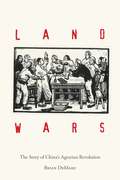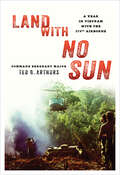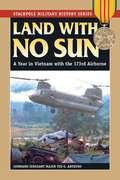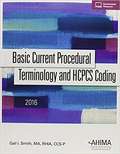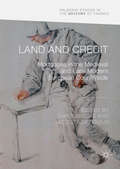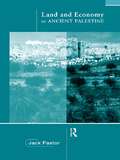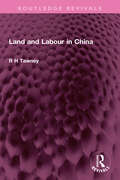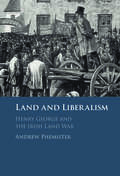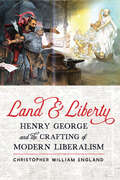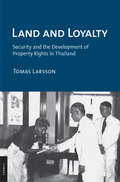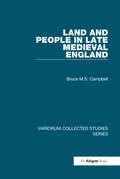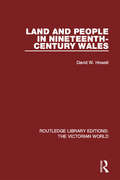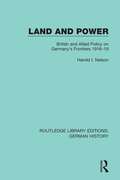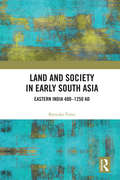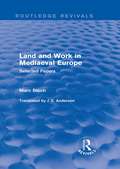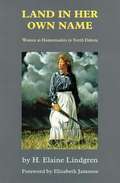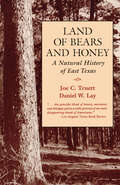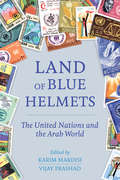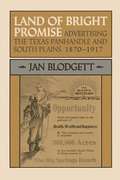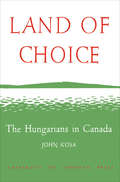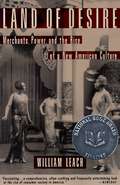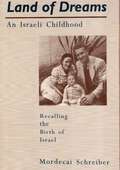- Table View
- List View
Land Wars: The Story of China's Agrarian Revolution
by Brian DeMareMao Zedong's land reform campaigns comprise a critical moment in modern Chinese history, and were crucial to the rise of the CCP. In Land Wars, Brian DeMare draws on new archival research to offer an updated and comprehensive history of this attempt to fundamentally transform the countryside. Across this vast terrain loyal Maoists dispersed, intending to categorize poor farmers into prescribed social classes, and instigate a revolution that would redistribute the land. To achieve socialist utopia, the Communists imposed and performed a harsh script of peasant liberation through fierce class struggle. While many accounts of the campaigns give false credence to this narrative, DeMare argues that the reality was much more complex and brutal than is commonly understood—while many villagers prospered, there were families torn apart and countless deaths. Uniquely weaving narrative and historical accounts, DeMare powerfully highlights the often devastating role of fiction in determining history. This corrective retelling ultimately sheds new light on the contemporary legacy of land reform, a legacy fraught with inequality and resentment, but also hope.
Land With No Sun: A Year in Vietnam with the 173rd Airborne
by Commander Ted G ArthursA first-person history of the action seen by the United States airborne infantry brigade in Vietnam, from a Silver Star awarded Command Sergeant Major. A no-holds-barred, straight-in-your-face account of combat in Vietnam. You know it's going to be hot when your brigade is referred to as a Fireball unit. From May 1967 through May 1968, Ted Arthurs was in the thick of it, humping an eighty-pound rucksack through triple canopy jungle, chasing down the Viet Cong and North Vietnamese in the Central Highlands of South Vietnam. As sergeant major for a battalion of eight-hundred men, it was his job to see them through this jungle hell and get them back home again.
Land With No Sun: A Year in Vietnam with the 173rd Airborne (Stackpole Military History Series)
by Ted G. ArthursA no-holds-barred, straight-in-your-face account of combat in Vietnam.
Land and Book
by Scott Thompson SmithIn this original and innovative study, Scott T. Smith traces the intersections between land tenure and literature in Anglo-Saxon England. Smith aptly demonstrates that as land became property through the operations of writing, it came to assume a complex range of conceptual values that Anglo-Saxons could use to engage a number of vital cultural concerns beyond just the legal and practical - such as political dominion, salvation, sanctity, status, and social and spiritual obligations.Land and Book places a variety of texts - including charters, dispute records, heroic poetry, homilies, and the Anglo-Saxon Chronicle - in a dynamic conversation with the procedures and documents of land tenure, showing how its social practice led to innovation across written genres in both Latin and Old English. Through this, Smith provides an interdisciplinary synthesis of literary, legal, and historical interests.
Land and Credit: Mortgages In The Medieval And Early Modern European Countryside (Palgrave Studies in the History of Finance)
by Chris Briggs Jaco ZuijderduijnThis volume investigates the use of mortgages in the European countryside between the thirteenth and eighteenth centuries. A mortgage allowed a loan to be secured with land or other property, and the practice has been linked to the transformation of the agrarian economy that paved the way for modern economic growth. Historians have viewed the mortgage both positively and negatively: on the one hand, it provided borrowers with opportunities for investment in agriculture; but equally, it exposed them to the risk of losing their mortgaged property. The case studies presented in this volume reveal the variety of forms that the mortgage took, and show how an intricate balance was struck between the interests of the borrower looking for funds, and those of the lender looking for security. It is argued that the character of mortgage law, and the nature of rights in land in operation in any given the place and period, determined the degree to which mortgages were employed. Over time, developments in these factors allowed increasing numbers of peasants to use mortgages more freely, and with a decreasing risk of expropriation. This volume will be appealing to academics and researchers interested in financial history, rural credit and debt, and the economic history of agrarian communities.
Land and Economy in Ancient Palestine
by Jack PastorLand and Economy in Ancient Palestine is a study of the economic crises throughout the Second Temple Period. It establishes that the single factor of the economy which united all aspects of life in ancient society was land.Through study of a wide variety of sources, including the New Testament and classical authors, Jack Pastor looks at who owned land, and how they came to possess it. He examines the various ramifications of landownership in ancient society to ascertain its effect on livelihoods, government policies and revenues. A special emphasis is placed on debt and famine as social and economic problems with ties to the landholding structure.
Land and Labour in China (Routledge Revivals)
by R H Tawney dec'dFirst published in 1932 Land and Labour in China is an introductory volume dealing with certain aspects of economic life in China. R. H. Tawney discusses important themes ranging from rural framework, problems of the peasant to the growth of capitalist industry in China
Land and Liberalism: Henry George and the Irish Land War
by Andrew PhemisterIrish land in the 1880s was a site of ideological conflict, with resonances for liberal politics far beyond Ireland itself. The Irish Land War, internationalised partly through the influence of Henry George, the American social reformer and political economist, came at a decisive juncture in Anglo-American political thought, and provided many radicals across the North Atlantic with a vision of a more just and morally coherent political economy. Looking at the discourses and practices of these agrarian radicals, alongside developments in liberal political thought, Andrew Phemister shows how they utilised the land question to articulate a natural and universal right to life that highlighted the contradictions between liberty and property. In response to this popular agrarian movement, liberal thinkers discarded many older individualistic assumptions, and their radical democratic implications, in the name of protecting social order, property, and economic progress. Land and Liberalism thus vividly demonstrates the centrality of Henry George and the Irish Land War to the transformation of liberal thought.
Land and Liberty: Henry George and the Crafting of Modern Liberalism (Hagley Library Studies in Business, Technology, and Politics)
by Christopher William EnglandA comprehensive history of Henry George and the single tax movement.In 1912, Sun Yat-sen announced the birth of the Chinese Republic and promised that it would be devoted to the economic welfare of all its people. In shaping his plans for wealth redistribution, he looked to an American now largely forgotten in the United States: Henry George. In Land and Liberty, Christopher William England excavates the lost history of one of America's most influential radicals and explains why so many activists were once inspired by his proposal to tax landed wealth. Drawing on the private papers of a network of devoted believers, Land and Liberty represents the first comprehensive account of this important movement to nationalize land and expropriate rent. Beginning with concerns about rising rents in the 1870s and ending with the establishment of New Deal policies that extended public control over land, natural resources, and housing, "Georgism" served as a catalyst for reforms intended to make the nation more democratic. Many of these concerns remain relevant today, including the exploitation of natural resources, rising urban rent, and wealth inequality. At a time when class divisions sparked fears that capitalism and democracy were incompatible, hopes of building a social welfare state using the rents of idle landlords revitalized the middle class's conviction that democracy and liberty could be reconciled. Against steep odds, George made land nationalization vital to the politics of a nation dominated by small farmers and helped push liberalism leftward through his calls for collective rights to land and natural resources.
Land and Loyalty: Security and the Development of Property Rights in Thailand (Cornell Studies in Political Economy)
by Tomas LarssonDomestic and international development strategies often focus on private ownership as a crucial anchor for long-term investment; the security of property rights provides a foundation for capitalist expansion. In recent years, Thailand's policies have been hailed as a prime example of how granting formal land rights to poor farmers in low-income countries can result in economic benefits. But the country provides a puzzle: Thailand faced major security threats from colonial powers in the nineteenth century and from communism in the twentieth century, yet only in the latter case did the government respond with pro-development tactics.In Land and Loyalty, Tomas Larsson argues that institutional underdevelopment may prove, under certain circumstances, a strategic advantage rather than a weakness and that external threats play an important role in shaping the development of property regimes. Security concerns, he find, often guide economic policy. The domestic legacies, legal and socioeconomic, resulting from state responses to the outside world shape and limit the strategies available to politicians. While Larsson's extensive archival research findings are drawn from Thai sources, he situates the experiences of Thailand in comparative perspective by contrasting them with the trajectory of property rights in Japan, Burma, and the Philippines.
Land and People in Late Medieval England (Variorum Collected Studies)
by Bruce M.S. CampbellThis is the third collection of articles by Bruce Campbell to appear in the Variorum series. Late medieval England was an overwhelmingly rural society. Never since has such a large proportion of the population lived in the countryside or relied so directly for its livelihood upon agriculture. The lot of a majority of that population was always a hard one - and never more so than during the first half of the 14th century, when peasants competed with each other for ever-scarcer land and work and a succession of major harvest failures jeopardised the survival of many. Nevertheless, experience varied considerably, both during this era of mounting population pressure and the century and more of population decline and stagnation that followed the demographic disaster of the Black Death. How well individual communities coped during these contrasting conditions of expansion and contraction owed much to the quality and composition of their natural-resource endowment, a good deal to their ability to take advantage of changing commercial opportunities, and sometimes almost everything to how exposed they were to military conflict. Always, however, much hinged upon how the twin feudal institutions of lordship and serfdom were mapped onto land and people via the manorial system. These are the themes variously explored by the eight essays assembled in this volume, which range from a case-study of a single crowded Norfolk manor to a consideration of the broad and, towards the end of the Middle Ages, widening contrasts that persisted between North and South.
Land and People in Nineteenth-Century Wales (Routledge Library Editions: The Victorian World #28)
by David W. HowellFirst published in 1977. Essentially an economic history with strong emphasis on human factors, this title examines the reasons for the backwardness of much of the farming of Wales and discusses in detail how agricultural resources and organisation directly affected the nature of social relationships within the community. This study will be of central importance to students of the history of Wales. It should appeal equally to those interested in the economic history of late modern Britain; students of nineteenth-century British Agriculture and the rural community; historical geographers; and all those concerned with peasants and peasant societies.
Land and Power: British and Allied Policy on Germany's Frontiers 1916-19 (Routledge Library Editions: German History #32)
by Harold I. NelsonOriginally published in 1963, this book examines the territorial settlement with Germany at the end of the First World War. It approaches it from the standpoint of British official attitudes and policy in order to discover the pre-Paris-Peace-Conference evolution of British governmental thinking on German boundary issues: to bring out the relationship between British attitudes and those of their allies and to determine British influence on the drafting of the territorial provisions of the ill-fated Treaty of Versailles.
Land and Privilege in Byzantium
by Mark C. BartusisA pronoia was a type of conditional grant from the emperor, often to soldiers, of various properties and privileges. In large measure the institution of pronoia characterized social and economic relations in later Byzantium, and its study is the study of later Byzantium. Filling the need for a comprehensive study of the institution, this book examines the origin, evolution and characteristics of pronoia, focusing particularly on the later thirteenth and fourteenth centuries. But the book is much more than a study of a single institution. With a broad chronological scope extending from the mid-tenth to the mid-fifteenth century, it incorporates the latest understanding of Byzantine agrarian relations, taxation, administration and the economy, as it deals with relations between the emperor, monastic and lay landholders, including soldiers and peasants. Particular attention is paid to the relation between the pronoia and Western European, Slavic and Middle Eastern institutions, especially the Ottoman timar.
Land and Society in Early South Asia: Eastern India 400–1250 AD
by Ryosuke FuruiThis volume explores the process of social changes which unfolded in rural society of early medieval Bengal, especially the formation of stratified land relations and occupational groups which later got systematised as jātis. One of the first books to systematically reconstruct the early history of the region, this book presents a history of the economy, polity, law, and social order of early medieval Bengal through a comprehensive study of land and society. It traces the changing power relations among constituents of rural society and political institutions, and unravels the contradictions growing among them. The author describes the changing forms of agrarian development which were deeply associated with these overarching structures and offers an in-depth analysis of a wide range of textual sources in Sanskrit and other languages, especially contemporary inscriptions pertaining to Bengal. The volume will be an essential resource for researchers and academics interested in the history of Bengal, and the social and economic history of early South Asia.
Land and Work in Mediaeval Europe: Selected Papers (Routledge Revivals: Selected Works of Marc Bloch)
by Marc BlochLand and Work in Mediaeval Europe was first published in English in 1967. Throughout the work, the idea that Marc Bloch was not only a historian but a great teacher is exemplified, as is his ability to ask interesting and original questions through his writing. Topics covered include medieval Germany, technical problems in the medieval economy and society, and the medieval class structure.
Land in Her Own Name: Women as Homesteaders in North Dakota
by H. Elaine Lindgren"Land is often known by the names of past owners. "Emma's Land," "Gina's quarter," and "the Ingeborg Land" are reminders of the many women who homesteaded across North Dakota in the late nineteenth and early twentieth centuries. Land in Her Own Name records these homesteaders' experiences as revealed in interviews with surviving homesteaders and their families and friends, land records, letters, and diaries." "These women's fascinating accounts tell of locating a claim, erecting a shelter, and living on the prairie. Their ethnic backgrounds include Yankee, Scandinavian, German, and German-Russian, as well as African-American, Jewish, and Lebanese. Some were barely twenty-one, while others had reached their sixties. A few lived on their land for life and "never borrowed a cent against it"; others sold or rented the land to start a small business or to provide money for education."--BOOK JACKET. Title Summary field provided by Blackwell North America, Inc. All Rights Reserved
Land of 10,000 Loves: A History of Queer Minnesota
by Stewart Van CleveFor too long, LGBTQ communities—including Minnesota&’s—have been maligned, misrepresented, and often outright ignored. Myths regarding the queer experience have grown and become embedded in local and national consciousness. The absence of queer stories over time in local historical and popular writing only served to further this ignorance, but great strides have been made in recent decades to celebrate Minnesota&’s vibrant queer history. Add to this rising chorus an enchanting new voice: Land of 10,000 Loves, Stewart Van Cleve&’s wide-ranging and unprecedented illustrated history of queer life in Minnesota.Drawing from the renowned Tretter Collection at the University of Minnesota—a vast collection of books, photographs, films, and other historical artifacts that Van Cleve calls &“one of the most comprehensive accounts of international queer history in the world&”—Land of 10,000 Loves blends oral history, archival narrative, newspaper accounts, and fascinating illustrations to paint a remarkable picture of Minnesota&’s queer history. More than 120 concise historical essays lead readers from the earliest evidences of queer life in Minnesota before the Second World War—for example, Oscar Wilde&’s visit to Minnesota and &“rumors&” at the Alexander Ramsey house—to riverfront vice districts, protest and parade sites, bars, 1970s collectives, institutions, public spaces, and private homes. More than 130 illustrations illuminate these histories with images of pride guides, archival photographs, and advertisements from local queer bars among other extraordinary pieces of ephemera and artifacts. Many of the stories and images are well known, while others have been all but forgotten, until now.Building on foundational works of regional queer history such as The Evening Crowd at Kirmser&’s and Queer Twin Cities, the historical vignettes of Land of 10,000 Loves show us that Minnesota—from its biggest cities to its smallest towns—has been, as Van Cleve notes, &“queer, to a certain extent, since the very beginning.&” Land of 10,000 Loves honors this rich and diverse legacy and is a compelling testament to the sacrifices, scandals, and victories that have affected and continue to affect the lives of queer Minnesotans.
Land of Bears and Honey: A Natural History of East Texas
by Joe C. Truett Daniel W. LayThis award-winning &“gem&” of a conservation classic tells the story of the land, wildlife, and ecology of East Texas (Quarterly Review of Biology).Winner of the Ottis Lock Endowment Award from the East Texas Historical Association; the Texas Literary Festival Award for Nonfiction from the Southwestern Booksellers Association & Dallas Times Herald; and the Annual Publication Award, Texas Chapter of the Wildlife Society As hickory groves and fox squirrels began to vanish from the East Texas landscape in the second half of the twentieth century, two biologists who specialized in wildlife and endangered species began work on Land of Bears and Honey. Their purpose was not only to eulogize what was lost, but to encourage us to save what we still can. The result is an &“elegant chronicle of the natural history of a once-rich area [that] will appeal strongly to birders, ecologists, to anyone who enjoys the outdoors&” (Publishers Weekly). &“This deceptively slender volume is three things: a how-to-book, an aesthetic feast and a moral tale.&” —Dallas Morning News &“To compare the style and content of this little book to that of the late Aldo Leopold is indeed high praise, yet the reviewer finds this comparison valid.&” —Quarterly Review of Biology &“In Land of Bears and Honey, East Texans have their own regional Walden, written with keen historical perspectives, literary style, and deep respect for the land.&” —East Texas Historical Journal &“This graceful blend of history, narrative and dialogue paints a noble portrait of one more disappearing chunk of Americana.&” —Los Angeles Times Book Review
Land of Bears and Honey: A Natural History of East Texas
by Joe C. Truett Daniel W. LayThis award-winning &“gem&” of a conservation classic tells the story of the land, wildlife, and ecology of East Texas (Quarterly Review of Biology).Winner of the Ottis Lock Endowment Award from the East Texas Historical Association; the Texas Literary Festival Award for Nonfiction from the Southwestern Booksellers Association & Dallas Times Herald; and the Annual Publication Award, Texas Chapter of the Wildlife Society As hickory groves and fox squirrels began to vanish from the East Texas landscape in the second half of the twentieth century, two biologists who specialized in wildlife and endangered species began work on Land of Bears and Honey. Their purpose was not only to eulogize what was lost, but to encourage us to save what we still can. The result is an &“elegant chronicle of the natural history of a once-rich area [that] will appeal strongly to birders, ecologists, to anyone who enjoys the outdoors&” (Publishers Weekly). &“This deceptively slender volume is three things: a how-to-book, an aesthetic feast and a moral tale.&” —Dallas Morning News &“To compare the style and content of this little book to that of the late Aldo Leopold is indeed high praise, yet the reviewer finds this comparison valid.&” —Quarterly Review of Biology &“In Land of Bears and Honey, East Texans have their own regional Walden, written with keen historical perspectives, literary style, and deep respect for the land.&” —East Texas Historical Journal &“This graceful blend of history, narrative and dialogue paints a noble portrait of one more disappearing chunk of Americana.&” —Los Angeles Times Book Review
Land of Blue Helmets: The United Nations and the Arab World
by Vijay Prashad Karim MakdisiBorn in 1945, the United Nations came to life in the Arab world. It was there that the UN dealt with early diplomatic challenges that helped shape its institutions such as peacekeeping and political mediation. It was also there that the UN found itself trapped in, and sometimes part of, confounding geopolitical tensions in key international conflicts in the Cold War and post-Cold War periods, such as hostilities between Palestine and Iraq and between Libya and Syria. Much has changed over the past seven decades, but what has not changed is the central role played by the UN. This book's claim is that the UN is a constant site of struggle in the Arab world and equally that the Arab world serves as a location for the UN to define itself against the shifting politics of its age. Looking at the UN from the standpoint of the Arab world, this volume collects some of the finest scholars and practitioners writing about the potential and the problems of a UN that is framed by both the promises of its Charter and the contradictions of its member states. This is a landmark book--a close and informed study of the UN in the region that taught the organization how to do its many jobs.
Land of Bright Promise: Advertising the Texas Panhandle and South Plains, 1870-1917
by Jan Blodgett"It shall be the chosen land, perpetual sunshine shall kiss its trees and vines, and, being storied in luscious fruits and compressed into ruddy wine, will be sent to the four points of the compass to gladden the hearts of all mankind . . . They will breathe the pure and bracing air, bask in the healing sunshine, drink the invigorating wine, and eat the lifeprolonging fruit. "-from a brochure advertising the Staked Plains fromthe Missouri Pacific Railway Company, 1889Land of Bright Promise is a fascinating exploration of the multitude of land promotions and types of advertising that attracted more than 175,000 settlers to the Panhandle-South Plains area of Texas from the late years of the nineteenth century to the early years of the twentieth. Shunned by settlers for decades because of its popular but forbidding image as a desert filled with desperados, savage Indians, and solitary ranchers, the region was seen as an agricultural and cultural wasteland. The territ0ry, consequently, was among the last to be settled in the United States. But from 1890 to 1917, land companies and agents competed to attract new settlers to the plains. To this end, the combined efforts of local residents, ranchers and landowners, railroads, and professional real estate agents were utilized. Through brochures, lectures, articles, letters, fairs, and excursion trips, midwestern farmers were encouraged to find new homes on what was once feared as the "Great American Desert. " And successful indeed were these efforts: from 13,787 in 1890, the population grew to 193,371 in 1920, with a corresponding increase in the amount of farms and farm acreage. The book looks at the imagination, enthusiasm, and determination of land promoters as they approached their task, including their special advertisements and displays to show the potential of the area. Treating the important roles of the cattlemen, the railroads, the professional land companies, and local boosters, Land of Bright Promise also focuses on the intentions and expectations of the settlers themselves. Of special interest are the fifteen historical photographs and reproductions of promotional pieces from the era used to spur the land boom. What emerges is an engaging look at a critical period in the development of the Texas Panhandle and an overview of the shift from cattle to agriculture as the primary industry in the area.
Land of Choice: The Hungarians in Canada
by John KosaWritten by a Hungarian scholar who himself passed through the vicissitudes of migration and assimilation, this timely study of the movement of Hungarians into Canada has a special value. The author, a graduate of the University of Budapest, taught social history and sociology at the universities of Budapest and Szeged, and had already written considerably on the specific sociological problems he now describes before he entered Canada as an immigrant in 1950.<P><P> On Professor Kosa's arrival in North America, his academic interest perforce became practical. Now with a broader insight into the life of the immigrant, he carried out systematic research for the Department of Citizenship and Immigration among his fellow countrymen in Canada. Taking as a sample 112 Hungarian families who had entered the country before 1939, he had a mature immigrant group. Their locale was Toronto and the tobacco district of south-western Ontario.<P> This book describes the life and assimilation of these people into a new culture, the problems they faced, and the adjustments made. It will appeal to teachers and students of sociology and anthropology, to the general reader interested in the current Hungarian influx and in the growth of the Canadian community, and to Hungarians who have recently entered Canada. Both timely and scholarly, this is a detailed and careful documentation of what is happening to an important segment of Canadian society.<P>
Land of Desire: Merchants, Power, and the Rise of a New American Culture
by William R. LeachThis monumental work of cultural history was nominated for a National Book Award. It chronicles America's transformation, beginning in 1880, into a nation of consumers, devoted to a cult of comfort, bodily well-being, and endless acquisition.
Land of Dreams: An Israeli Childhood
by Mordecai SchreiberThis memoir, written by a native son, recalls everyday life before, during, and after the birth of the State of Israel.
